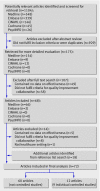Evidence for the impact of quality improvement collaboratives: systematic review
- PMID: 18577559
- PMCID: PMC2440907
- DOI: 10.1136/bmj.39570.749884.BE
Evidence for the impact of quality improvement collaboratives: systematic review
Abstract
Objective: To evaluate the effectiveness of quality improvement collaboratives in improving the quality of care.
Data sources: Relevant studies through Medline, Embase, PsycINFO, CINAHL, and Cochrane databases.
Study selection: Two reviewers independently extracted data on topics, participants, setting, study design, and outcomes.
Data synthesis: Of 1104 articles identified, 72 were included in the study. Twelve reports representing nine studies (including two randomised controlled trials) used a controlled design to measure the effects of the quality improvement collaborative intervention on care processes or outcomes of care. Systematic review of these nine studies showed moderate positive results. Seven studies (including one randomised controlled trial) reported an effect on some of the selected outcome measures. Two studies (including one randomised controlled trial) did not show any significant effect.
Conclusions: The evidence underlying quality improvement collaboratives is positive but limited and the effects cannot be predicted with great certainty. Considering that quality improvement collaboratives seem to play a key part in current strategies focused on accelerating improvement, but may have only modest effects on outcomes at best, further knowledge of the basic components effectiveness, cost effectiveness, and success factors is crucial to determine the value of quality improvement collaboratives.
Conflict of interest statement
Competing interests: LMTS and JJEvE work at the Dutch Institute for Quality Improvement. The views and opinions expressed are those of the authors and do not necessarily reflect those of the institute.
Figures
Comment in
-
Effects of quality improvement collaboratives.BMJ. 2008 Jun 28;336(7659):1448-9. doi: 10.1136/bmj.a216. Epub 2008 Jun 24. BMJ. 2008. PMID: 18577558 Free PMC article.
References
-
- Plsek PE. Collaborating across organizational boundaries to improve the quality of care. Am J Infect Control 1997;25:85-95. - PubMed
-
- Ayers LR, Beyea SC, Godfrey MM, Harper DC, Nelson EC, Batalden PB. Quality improvement learning collaboratives. Qual Manag Health Care 2005;14:234-47. - PubMed
-
- Mittman BS. Improving patient care. Creating the evidence base for quality improvement collaboratives. Ann Intern Med 2004;140:897-901. - PubMed
Publication types
MeSH terms
LinkOut - more resources
Full Text Sources
Other Literature Sources
Medical
Molecular Biology Databases

